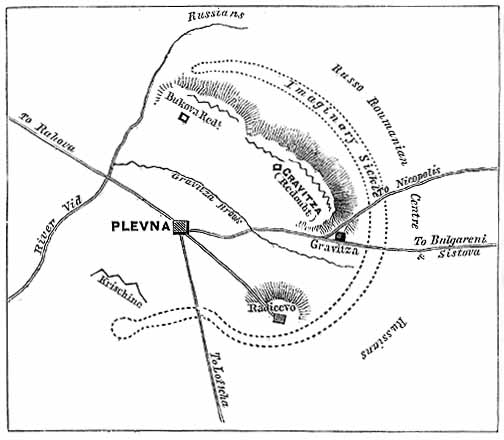|
Siege Of Plevna
The siege of Pleven, was a major battle of the Russo-Turkish War of 1877–1878, fought by the joint army of Russia and Romania against the Ottoman Empire. After the Russian army crossed the Danube at Svishtov, it began advancing towards the centre of modern Bulgaria, with the aim of crossing the Balkan Mountains to Constantinople, avoiding the fortified Turkish fortresses on the Black Sea coast. The Ottoman army led by Osman Pasha, returning from Serbia after a conflict with that country, was massed in the fortified city of Pleven, a city surrounded by numerous redoubts, located at an important road intersection. After two unsuccessful assaults, in which he lost valuable troops, the commander of the Russian troops on the Balkan front, Grand Duke Nicholas of Russia insisted by telegram the help of his Romanian ally King Carol I. King Carol I crossed the Danube with the Romanian Army and was placed in command of the Russian-Romanian troops. He decided not to make any more ... [...More Info...] [...Related Items...] OR: [Wikipedia] [Google] [Baidu] |
Grivitsa
Grivitsa ( bg, Гривица, ; also transliterated as ''Grivitza'' or ''Grivica'') is a village in Pleven Municipality, Pleven Province, central northern Bulgaria. It is primarily known as the site of one of the key engagements in the Siege of Plevna during the Russo-Turkish War of 1877–1878. Geography Located 9 kilometres east of Pleven at an average 208 metres above sea level and lying in the hilly basin of the Vit River, Grivitsa has a population of 1,778 as of December 2009. The railway line connecting Sofia to Varna and Rousse runs through the village, as well as the main road from Pleven to Rousse, Nikopol and Pordim. The highest point of the Central Danubian Plain, the 304-metre-high ''Sredni vrah'' ( bg, Средни връх, "Middle Peak") is just to the east of the village. The soil is rich in clay but suitable for agriculture. The area is also rich in limestone and quarries for its extraction have been built in several places. History The village's locatio ... [...More Info...] [...Related Items...] OR: [Wikipedia] [Google] [Baidu] |
Russian Empire
The Russian Empire was an empire and the final period of the Russian monarchy from 1721 to 1917, ruling across large parts of Eurasia. It succeeded the Tsardom of Russia following the Treaty of Nystad, which ended the Great Northern War. The rise of the Russian Empire coincided with the decline of neighbouring rival powers: the Swedish Empire, the Polish–Lithuanian Commonwealth, Qajar Iran, the Ottoman Empire, and Qing China. It also held colonies in North America between 1799 and 1867. Covering an area of approximately , it remains the third-largest empire in history, surpassed only by the British Empire and the Mongol Empire; it ruled over a population of 125.6 million people per the 1897 Russian census, which was the only census carried out during the entire imperial period. Owing to its geographic extent across three continents at its peak, it featured great ethnic, linguistic, religious, and economic diversity. From the 10th–17th centuries, the land ... [...More Info...] [...Related Items...] OR: [Wikipedia] [Google] [Baidu] |


